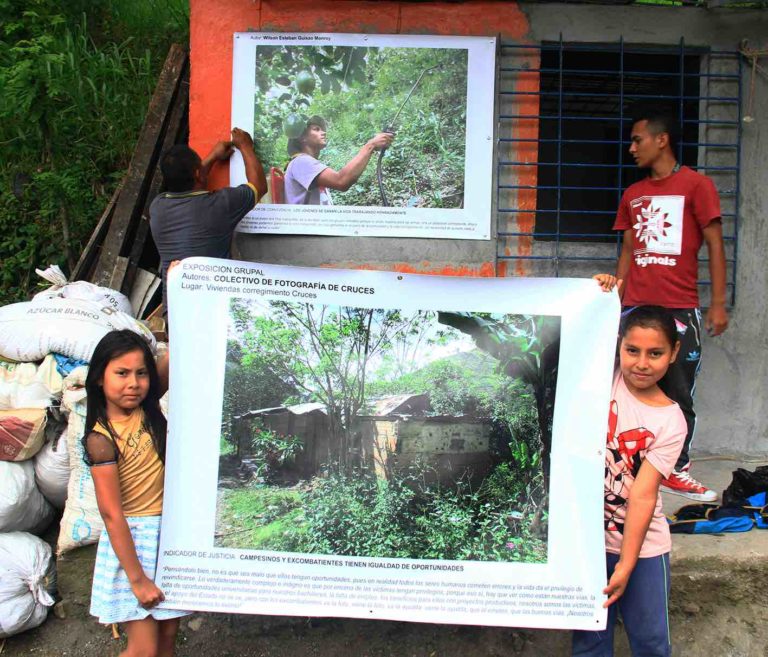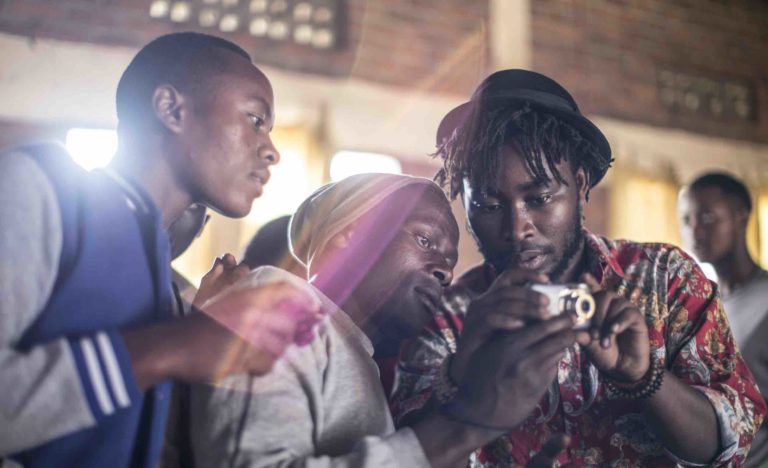Imaging Peace is a 3-year Leverhulme research project that is looking at how participatory, citizen and community photographic initiatives act as (implicit or explicit) forms of peace photography or strategic visual peacebuilding. The project is exploring how community engaged and participatory photographic practices are being harnessed to foster resilience and dialogue, to embed peace and to support the healing and re-building of people and communities in countries and places with recent histories of violence and conflict.
This research seeks to contribute to the emergence of peace photography as a visual genre and practice. Following Frank Möller’s proposal to ‘re-discover and appropriate existing photographic work as peace photography’[1], I am building case-studies that explore the context, histories, methods and reception of participatory and community peace photography ‘in action’. The aim is to develop critical knowledge about how these forms of ‘proactive’[2] photography act as a tool to build peace and dialogue. The focus is not so much on how peace is represented visually but rather on how images and image-making might serve to contribute to the actual construction and shaping of peace and dialogue.
Undertaking research into arts-based peacebuilding I noted how research to date has focused on the performative arts such as theatre and music[3]. There has been a distinct neglect of the visual. I am working with photographic practitioners and organisations in 6-7 countries to research photographic initiatives, collectives, and archives to build grounded theory on visual peace work in action. At the core of these projects is an expanded sense of what photography involves. It is an understanding of photography, as sketched out by Ariella Azoulay and others, as an ongoing, multi-participated activity, linked to political imaginaries and that invents new forms of being with others.
A focus on the process, on the making of images and on the ‘doing’ of photography, is a defining characteristic of peace photography[4]. While the resulting images of course have important roles to play, in the projects I am researching it is the process of creating images, looking at pictures, having conversations with and through photographs, that builds the agency, dialogue and critical engagement that are the vital ingredients of peace.
In the Home Stay Exhibitions in Rwanda, young photographers are turning their homes into exhibitions spaces to start conversations with their neighbors on the issues that they think are important to their community. In Colombia, villagers are taking photographs of their everyday peace indicators to identify and make visible what peace actually looks like in their locales. In Mexico, indigenous photographers chose not to focus on the conflicts and tensions that define their day-to-day realities but rather to turn their cameras to documenting and honoring their cultures, traditions, and family histories.
Everyday Peace Photography
There have been some initial explorations and references to participatory and community photography projects as forms of peace photography by Fred Ritchin[5] and Frank Möller[6] but to date the main focus has been on professionally driven image-making and specific bodies of photographic work produced by artist and documentary photographers.
Participatory and community photography have long struggled to be taken seriously. Falling outside of established, vertical photographic traditions they have been largely overlooked by photographic curators, writers and historians due to their vernacular and collective character and out of a latent value judgement over what kinds of photography and photographic activities are valid and warrant attention.
However visual peace researchers ignore this rich terrain of photographic practices at their peril. It is precisely in their vernacularity that we have so much to learn about peace from these projects and their images. The notion of everyday peace highlights the significance of day-to-day practices and strategies that people in conflict affected communities use to navigate and survive[7]. Photography is the medium par excellence for capturing and holding the fragments of the everyday. Many of the projects I am researching consist of an everyday peace photography that runs in all directions revealing the multiple ways peace is imagined, realised and sustained.
Everyday peace photography focuses on the mundane but also pushes beyond it and points to what is not visible. When young people in Northern Ireland created an image in which they digitally removed the peace wall that separated their community for more than 50 years they visualised something that does not actually exist[8]. When peace is understood as a potentiality that requires the creative capacity to imagine, to take risks and to recognise possibilities then the dialogical potency of everyday photography takes on a new relevance.
Peace Photography as both an implicit and explicit activity
These projects do not necessarily frame themselves as forms of peace photography. Only two of the seven case studies that I am currently researching consciously talk about peace.
Peace is a contested concept and can, in some contexts, be a loaded term. Previously I have explored how reconciliation can emerge as an implicit, rather than explicit, outcome or by-product of arts activity[9]. It is not that these community or citizen photographers don’t want to talk about peace but rather that in an environment where much control has been taken away from them, they want to frame their worlds on their own terms. As this research evolves, I will be exploring the tension between explicit and implicit forms of peace photography and how they contribute to the plural peace potentialities of photography.
About the Author
Dr. Tiffany Fairey is a Leverhulme Early Career Fellow in the Department of War Studies, King’s College London and the founder of PhotoVoice, which she ran for over 10 years. Since 2017, she has been engaged with Art & Reconciliation, an interdisciplinary research project, led by King’s College London in partnership with the London School of Economics and Political Science and the University of the Arts London.
You can read more about the Imaging Peace project in our blog post from August 2021.
[1] Möller 2020.
[2] Ritchin 2013: 123.
[3] Fairey 2017.
[4] Möller 2019.
[5] Ritchin 2013.
[6] Möller 2013, 2018.
[7] MacGinty 2014.
[8] Fairey 2019.
[9] Fairey 2018.
REFERENCES
Azoulay, Ariella. 2012. Civil Imagination: A Political Ontology of Photography. New York: Verso.
Fairey, Tiffany. 2017. ‘The Arts in Peace-Building and Reconciliation: Mapping Practice’. Art & Reconciliation Working Paper Series. https://artreconciliation.org/research-activities/publications/.
Fairey, Tiffany. 2018. ‘Participatory Arts and Peace-Building: Embodying and Challenging Reconciliation’. In Participatory Arts for Invisible Communities: PAIC; Irena Sertić (Ed), 204–14.
Fairey, Tiffany. 2019. ‘One Photograph: (Un)Photographing Peace’. Photography and Culture 12 (3): 377–82. https://doi.org/10.1080/17514517.2019.1656425.
Mac Ginty, Roger. 2014. ‘Everyday Peace: Bottom-up and Local Agency in Conflict-Affected Societies’. Security Dialogue 45 (6): 548–64.
Möller, Frank. 2013. Visual Peace: Images, Spectatorship and the Politics of Violence. Houndmills: Palgrave Macmillan.
Möller, Frank. 2018. ‘Peace’. In Visual Global Politics, Roland Bleiker (Ed), 220–24. London and New York: Routledge.
Möller, Frank. 2019. Peace Photography. Houndmills: Palgrave Macmillan.
Möller, Frank. 2020. ‘Photography and Peace’. In The Palgrave Encyclopedia of Peace and Conflict Studies, Oliver Richmond and Gëzim Visoka (Eds). https://doi.org/10.1007/978-3-030-11795-5
Ritchin, Fred. 2013. Bending the Frame: Photojournalism, Documentary and the Citizen. New York: Aperture.
Zagreb, Croatia: Omnimedia. http://paic-project.eu/category/results/.



